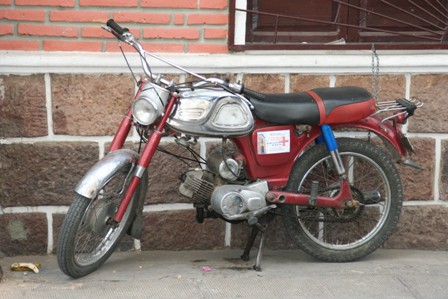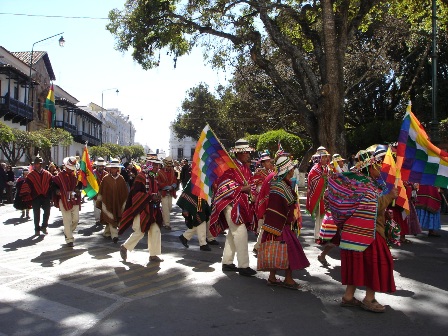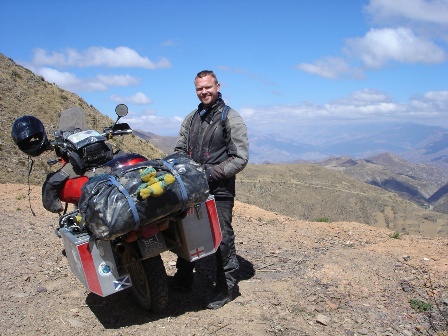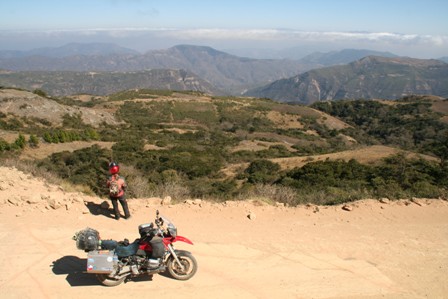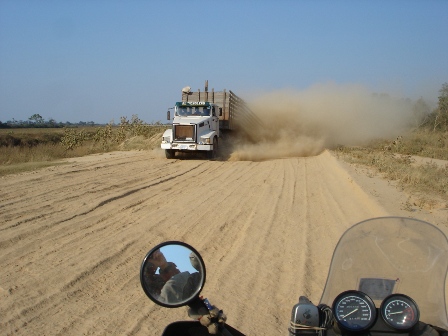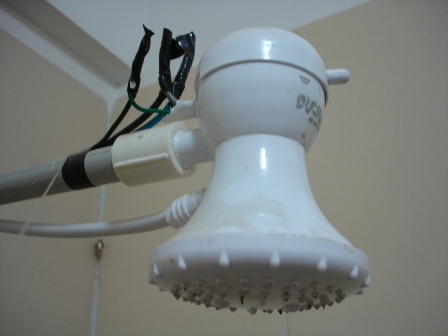Bolivia or Bust!

Sundance Kid (to Etta): Butch and me have been talking it all over. Wherever the hell Bolivia is, that's where we're off to.
(From the movie "Butch Cassidy and the Sundance Kid", 1969)
Unfortunately it was in Bolivia that the duo met their end at the hands of the Bolivian police, after they robbed several banks.
Che Guavara was also gunned down in Bolivia, after trying to take on the capitalist system and rouse the masses.
Hame and I didn't go to Bolivia to rob banks or start a revolution, but we did find lots of adventures...
Our first impression of Bolivia as we crossed the frontera at Villazon was hundreds of Bolivians struggling under the weight of sacks of cement, fruit and clothes, as they became human pack-horses for all the lorries crossing from Argentina. The lorries have to pay a tax if they cross fully loaded so it's cheaper for them to pay humans to carry each and every item across. As the people are paid by the sack, they try and run with these huge loads. We saw people of every age, both men and women, struggling under 50 kilo+ loads. It was a stark reminder that Bolivia is the poorest country in South America.

One of the things I love about travelling is the way everything is instantly different the minute you cross a border. Different food, dialect, dress... Villazon was a typical border town; a mass of sights colours sounds hustle and bustle. Fantastic!

We felt very welcome immediately as we attracted lots of attention in the plaza. Questions we've become used to - "Where are you from? Where are you going? How much was the bike? How fast...? Where are your children?" were fired at us and we chatted away with friendly people before heading North towards Tupiza.
The minute we left Villazon the road turned to ripio and I suddenly had the horrible thought that Boliva might not have many paved roads (not far from the truth as it turned out!). However, it was "good" ripio and there was lots to see on the way - tiny villages with adobe built houses; cacti of every size and shape; ancient Swedish registered lorries hurtling past (probably shipped over from Sweden when they started to fail the safety tests); hills and valleys and people who stared at us as if we were aliens.
Tupiza
A small town with a distinctly "wild west" feel to it, Tupiza is near the mining village of San Vincente where Butch and Sundance were killed (remember the bit at the end when the film froze, showing them running out of the building... that was San Vincente). We hired horses for an afternoon and rode around the area, visiting amazing areas of natural beauty. I'd had a bit of altitude sickness in the morning but the local remedy, a mouthful of coca leaves, soon sorted that out.

Emma Cassidy
In the evening we hooked up with Will, a Dutch guy and George, a rather eccentric American. We watched "Butch Cassidy and the Sundance Kid" and noticed that bits of Bolivia apparently haven't changed since 1907, when the film was set. After not seeing the film for years I'd forgotten that Bolivia was where they ended up.
Potosi
The road to Potosi was almost paved; long, tempting bits of concrete ran next to the sandy rutted diversion track that traffic was sent down. After a long, hot, bumpy and dusty ride we finally got on some tarmac and wound our way through Potosi's 400 year old streets in search of a hotel with parking. We treated ourselves to a plush hotel - ie, one that had an attached bathroom and a carpet, because I wanted to spend my birthday in style.
The day after we arrived I turned 35 (I'm no longer in my early 30s - argggghhh!) in the highest city in the world; fitting as Hame had his birthday in the Southernmost city in the world back in January.
At 4070 metres above sea level, Potosi was freezing at night and it was difficult to walk anywhere fast - even the smallest incline made us out of breath. Potosi is famous for the "Cerro Rico" (rich mountain) which overlooks town. Over the years the mountain has been mined for its silver and other mineral deposits, making the town rich and poor by turns as the mineral market fluctuated.

The Rich Mountain overlooking Potosi
We learned all about it in the main museum, housed in the former mint. Hame got all excited over the original 300 year old wooden minting machines, complete with their wooden gears. Yeah Hame, whatever!
Phwor! Gears... wheels.....
Potosi was a fascinating blend of Spanish colonial architecture, overhanging balconies, old cobbled streets, indigenous market stalls (selling everything from llama foetuses to nivea face cream) and streets full of shops selling mining equipment. It was interesting to see dynamite for sale, openly - apparently Potosi is the only place in the world where it's legal to sell it on the street.

Dried llama foetus, anyone?

Hats and dynamite
We hooked up with Will again and went on a tour of one of the mines. First we went to the miners' market to buy presents for the miners - coca leaves and fizzy drinks.

Then it was off to the mine, dressed in rather fetching shell suit pants and yellow hats. The mine we visited was a cooperative mine, meaning the miners work together and share any profits they make if they hit a particularly rich mineral line. The conditions were basic, to say the least. Fuelled by coca, fizz and 92% alcohol, miners work shifts of six hours, day and night. We spent four hours in the mine, in small tunnels, with dust in the air and water underfoot. We were allowed to watch the miners at work (in return for our gifts). There were both young and older men - the youngest we saw was a boy of 13.
Going down....
The bloke Hame gave his coca leaves to
At one point we had to descend 25m into a narrow shaft, down three vertical rickety ladders held on to the walls by bent nails, with rungs over a foot apart. I found it pretty scary.
Scary ladder
The trip was incredibly interesting but I was glad to be back outside. Over the last 400 years over eight million people have lost their lives in the mines of Potosi...
God of the mine; miners give him gifts of cigarettes, coca leaves and beer to keep themselves safe
In Potosi we discovered how cheap Bolivia can be; we found a cafe which sold four-course meals for US $2 - and that was the tourist price. This could be why Hame got Bolivan belly - but then Will reminded us that one night when we ate together Hame was so hungry he ate his fondue beef "rare", not able to wait for it to cook properly. Doh... He was fine after a day in bed. I had a tinge of it too, but I'm pretty sure it's just our systems adjusting to a different place. We've been fine since.
Raw meat, anyone?
While in Potosi there was one of the many strikes which are an everyday part of Bolivian life - this one was miners protesting against the goverment wanting to privatise the mines. Roads are blocked off, work stops and the strikers play football instead. Life grinds to a semi-halt because people cannot leave by road. Interesting. I doubt we would have been affected by it as we can ride around the blockades, but by the time we were ready to go it was all back to normal.
Leaving Potosi for Sucre, we had the treat of a perfect stretch of tarmac through stunning scenery (I know I've used that term a lot in the blogs, but it is all just stunning...) of hills and valleys.
Sucre
We'd had a mail from Grant and Jules saying they were returning to Argentina for various reasons, so would not be meeting us to ride the Corumba road after all. This gave us nothing to rush for so we returned to our normal speed of reverse and spent ten days in Sucre in the very lovely Pacha Mama hostel.
Maria making lunch at the hostel
A bike Hame had when he was 16, a Fizzy
We didn't waste time though, we were very industrious and enrolled in a course of Spanish lessons in the continuing attempt to become fluent (ha ha...). We liked our teachers so much we've decided to head back in a couple of months for more. Marie Theresa and Juan Pablo took us on individually (Hame and I have learnt through experience we don't study together so well!) and we both progressed well despite being taught nasty things like some of the many past tenses.
Hubble Bubble....
Marie Theresa and Juan Pablo took us for "stone soup", a delicious meaty, tomatoey concoction with a volcanic stone dropped in to heat it, causing it to bubble as if alive. They also took us to see Sucre Universario thrash The Strongest, from La Paz, our first experience of a local football game.
Such passion! So much passion that the crowd chucked lit fireworks about, although illegal to do so it happens at every match. It was quite an experience and as football is such an integral part of South American life, I'm glad we got the chance to see a game.

Street in Sucre
In Sucre Hame found an ATM with a Scottish accent... click below...
Scottish ATM
We both liked Sucre, its old Spanish buildings, markets selling CHEAP food (50p a meal), friendly folk and laid back vibe. We saw another demonstration - it was more like a carnival procession as indigenous people marched around the square protesting against their pay on farms, dressed in their traditional brightly coloured clothes, dancing and playing instruments.
La Paz is the capital of Bolivia and the seat of the Goverment, but the high court convenes in Sucre and many of its residents believe it should be capital instead. While we were there (you guessed it) there was a huge demo; thousands of people took to the streets and yelled "Sucre for Capital!" There's a lot of shouting in Bolivia. We didn't however see any trouble, although we heard that in La Paz there had been riots.


Street in Sucre
One evening we visited Marie Theresa's university class and told them all about Scotland and England and our trip. Hame did most of the talking and made a pretty good teacher, drawing a rather "stunning" map of the UK on the board and telling the students what Scotsmen wear under their kilts.
We managed a few nights out too with new friends met in the hostel, all that studying made for thirsty work!
A night in Joyride Cafe, the best spot in town
Once fluent in Spanish (NOT!) we left Sucre with promises to come back and do more teaching - Hame seems to have talked himself into giving a presentation to Marie Theresa's partner Rolando's engineering class - in Spanish. That should be interesting!
In Potosi we'd met an English couple on bicycles who recommended a back road to Santa Cruz. We'd written their instructions down on a bit of paper which we'd promptly lost, so it was all a bit of guesswork as the road didn't appear on any of our maps. However, off we went, in search of adventure and Che Guevara.
The Road to Samaipata/Santa Cruz
Sign on the road from Sucre
The first few kilometres were paved which was a treat, but then it was ripio for the next 350km. Hame wrestled with Bertha over a variety of surfaces, I hung on, and we enjoyed the views, which were, you got it, STUNNING! I'll let the photos describe it.
Despite our new fluency we struggled a bit to get reliable information about how far apart everything was. We were aiming for Pucara, a tiny village near "Che's last stand" but everyone we asked as we went along gave different answers. When we asked three times and the answer was always five hours, we decided to stop for the night in Villa Serrano.
Sometimes the road disappears...
The next day there were more views and more tiny roads, winding up and down hill after hill.
We got to Pucara, a tiny place nestled way up in the hills and found it to be a place where time had stood still. The only hotel had no electricity, hot water or food, but it did have two rather uncomfy beds for two dollars each.

Bertha outside the hotel
Kids outside our hotel
The only "restaurant" served us egg and chips and the entertainment in the evening was to sit around a gas lamp drinking tea in the local shop. The butcher killed a cow and gutted it in the main plaza and at night the stars shone bright with no electric lights to hide them. The roads through town were made of ancient cobbles, as uneven as could be.
The local butcher

I met the owner of the shop next door to the hotel; a 79 year old lady called Maria Rico who had a beautiful face and the spirit of a 30 year old. She'd had 15 children and had lived her life in Pucara, selling her wares from a dusty shop by day and in the light of a candle after dark. There were so many things I wanted to ask her but language got in the way.
Outside Maria's shop
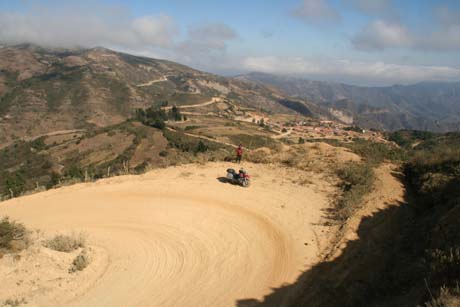
Pucara from above
We visited Che's last stand, at La Higuera. Here Che Guevara hid in the hills with his comrades after helping Fidel Castro in Cuba and plotted against the system, fighting injustice as he saw it. The CIA were after him and together with Bolvian troops they tracked him down, incarcerated him in the local school house and shot him. The school house has been converted into a small museum and on sale were tiny jars of sand impregnated with "the blood of Che".

The old school house where Che was killed

Che Guevara monument
We left the village where time has stood still and rode off, up and back into the hills. It was a very beautiful area and we noticed the flora changing - it was refreshing to see more green after all the dry barren country we've been in.
At Valle Grande we were stopped by the police and told the road was blocked for a race. We stopped and watched ten rally cars in varying states of repair racing through the village for a couple of hours.
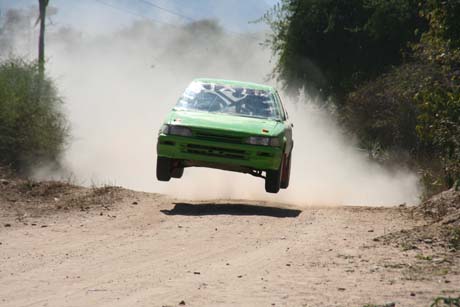
On the road again shortly afterwards we watched a guy do a full 360 on the gravel road 100m in front of us, obviously he'd got carried away watching the race and fancied himself as a rally driver.
Samaipata
Fast becoming a haven for foreigners who are fed up at home, Samaipata seemed to be full of Dutch and Germans! This meant we could buy great sausages and cheese but also meant prices weren't typically Bolivian. We decided to camp on a Dutch owned finca, La Vispera, and spent a tranquil week back in our canvas home, with views of the surrounding hills (full of big houses which apparently belong to local drug barons).
Samaipata is surrounded by excellent trekking routes and caves. It's also home to a pre Hispanic fuerte (fort) which Erik Von Daniken (author of "Chariots of the Gods") thought was an alien landing strip. It looked like an ancient fort to us, but who knows... The road winding up to it was steep and twisty and the fort itself was situated on a hill with magnificent views all around. The main part of the fort was a huge, intricately carved rock.
El Fuerte
We met Will again and joined him for a trek with the Dutch owner of his hostel, Andres. We trekked down into a valley in a place called Bella Vista, and it certainly was "bella" - beautiful, very green and lush, a bit like Malaysia...
Hame and Will trekking... click below...
Bella Vista
Hame gave Bertha a bath and noticed a crack in the fairing bracket which necessitated him stripping it down and taking it to be welded. The cause was probably all the dirt roads we've been on, it has been very bumpy lately...
Bracket repair
Tearing ourselves away from our peaceful campsite with its four star facilities and resident humming birds who visited the many flowers frequently during the day, we packed up and set off for Brazil where we hoped to meet Heather and Richard (our friends from Chile) in the Pantanal.
After a quick overnight in Santa Cruz with a visit to an Irish Bar, we headed out onto Ruta Four.
Ruta Four - the Road from Santa Cruz to Corumba (Dum dum duuuummmmm - dramatic music heard in the background)
I'm the navigator. That's my job. Unfortunately my map holder got eaten in the rear wheel so the map is on top of the tank bag, therefore Hame navigates now. If it had still been my job, we wouldn't have taken a 60km detour as we shot off down the wrong road... It was while eating empanadas at a roadside stall we realised we had to go back 60km - oops. They were delicious empanadas though, the best we've had for ages and almost worth the extra k's..
So back we went, through the soya and sunflower plantations and eventually found the correct road. To be fair, it wasn't exactly well-signposted (Bolivia isn't known for its signposts, people describe routes in hours, not distance most of the time) so no surprise we missed it.
We'd heard a few things about Ruta Four, not many though as few people are mad enough to ride it. We thought it'd take us a couple of days, not too difficult. After all, it couldn't be much worse than anything else we'd ridden, right? Wrong!
Right away there were signs for "road under construction". A crappy track ran alongside a road which will be very nice in a few years, but now is semi-ready, with huge piles of earth every two kilometres to stop you riding on it. It didn't stop us, because the track alongside was so rubbish but it was sometimes a hassle to get over/around the piles of dirt.
Around the humps....
... or over the top
This went on all afternoon. From time to time we saw people working on it which meant we had to resort to the diversion track. This had a range of surfaces - sand, deep sand, very deep sand, gravel, bulldust, rocks, corrugations and mud.
While on the mud I said, "Ooh, I'm not that used to being on mu-" then, SPLAT.
Oops!
Luckily we both landed on our feet like cats, giggling. Bulldust sprayed with water becomes like ice, even though it looks like nothing in the photo.
Soon after this the heat became unbearable. It had been getting hotter and hotter all day and we were melting inside our gear - I still had all my thermal liners zipped in. We stopped for a coke in a rare village and sat in an open-sided straw hut full of children watching "The Flintstones" dubbed into Spanish. Hame sang "Do you know the way to San Jose?" (as it was the next town) to the rather bewildered cafe owner, who said afterwards he was "romantic".
Back on the road and it just went on, and on, rubbish surface, bumps and so much bloody dust that every time a car or truck went past we were drenched in brown. It still seemed like fun at this point.
Another dust bath coming...
Because of our little detour in the morning we ran out of daylight before getting to the halfway point. Camping wasn't an option because we needed water. In a small settlement we were told there was a village with a hotel 22km down the road. 22km down the road there was indeed a village but no hotels in sight. Luckily for us, as it was by now dark, a very nice man called Alfreo who we'd asked for directions invited us back to his house. Alfreo had a battered old taxi - as well as a horse and cart - but the family business seemed to be a tiny shop which operated through a window in their bedroom. He and his wife Marina shared their small house with six children and a few grandchildren.
Alfreo showed us where we could park the bike, inside one corner of an open room built next to the "shop". This room doubled as the local bar as Marina sold beer so as night closed in we sat chatting to locals, watching the evening's entertainment - a home video of a festival (lots of dancing and beer) which had taken place in June in the village.
When everyone had gone Hame and I built our bed on the tarp on the floor and crashed out, exhausted. Despite various people arriving and leaving all night and the entire population of dogs barking late into the night, then the entire population of chickens cocking and doodling away taking over from 3 AM we rested, very grateful to the family.
A bed in the bar
Alfreo and some of his family
Everyone was up by six so we got an early start which was excellent for seeing bird life on the road; we saw loads of different species. The road was briefly quite good, but then continued to be dirt and bumps.
On the way the previous day we'd seen a few strange looking people driving around in horses and carts. They were very fair-skinned and blond, and they wore very old fashioned clothes. The women wore long dark dreses and boater hats, and the men wore those German trousers which come halfway up to your armpits (think The Sound of Music) or dungarees circa 1920s America and straw hats.
We stopped by a group of guys sitting outside a small cafe in their horse and cart listening to "Who let the dogs out.." and asked if we could take their photo. They were very friendly, some of them were quite out of it on coca and alcohol and they seemed to be speaking some kind of German dialect. One guy spoke English. Unfortunately we were worried about daylight at the time because I'd have liked to stay and ask lots of questions, but we had to press on. We think they were somehow related to the Mennonites, a group of German/Candian descendants who live in Paraguay.
Once in San Jose we stopped for a fabulous lunch and saw more of the German looking people about, it was most incongruous to see them strolling about a town full of Bolivians.
1930s America or Bolivia?
After San Jose the road was briefly good - a random stretch of perfect concrete wich took us to the next town. We rode all afternoon and stopped in Robore, a dusty town where we showered, washed and flopped very quickly.
The electric shock shower, a Bolivian speciality
The next day we fuelled up and rode until we reached a small settlement where we had more egg and chips, hard roads make you hungry. Poor Bertha, we were really putting her through hell... I have to say Hame rode well, it was hard enough hanging on, let alone riding. Good for my biceps anyway!
The road was briefly good before it remembered it was supposed to be rubbish, and went rubbish. Same old sand/bulldust/ruts and the heat! It was up in the high 30s and we were roasting, having been in cold places for months now.
It got hotter still and the temp guage read 45º. It was making me feel slightly ill and we had to make sure we drank enough. The afternoon dragged on and on, the road remained its usual crappy self and we kept going. At some point it stopped being quite so fun as we melted in our gear and bumped along. The scenery wasn't all that great either - crappy roads are fine if the scenery is fantastic to look at.
And on... and on....
By the late afternoon of the third day we finally got to the border with Brazil and breathed a big sigh of relief. It was okay, but probably the longest - 600+km - continually hard bit of road we've done, maybe because of the heat.
Covered in dust, tired and very hot, we signed out of Bolivia for the time being.
We've loved the country, it instantly became my fave so far (yes I know I say that about everywhere) with great vistas and sounds, friendly people and lots to see, plus, it is very cheap to live! It reminded me a lot of being back in Asia.
Bolivian Village video, click below...
Bolivia!
We'll be back to Bolivia in a few weeks - after a trip through Brazil, to Iguazu, Buenos Aires and back through Paraguay. Though knowing us the plans will change...
(Emma)
Too much road?

Not letting a little thing like being on a bike stop me from gardening, I've found a way to grow bean sprouts on the bike. Exciting, huh?










